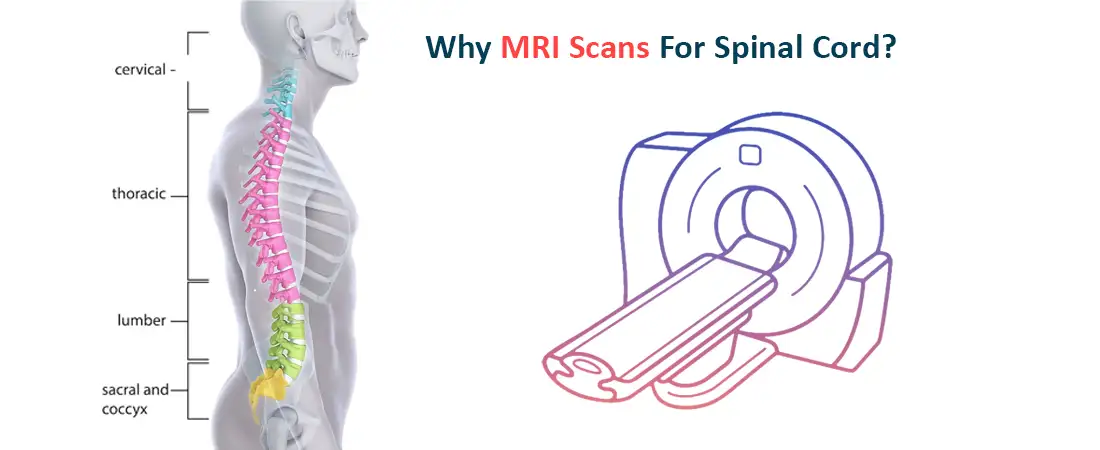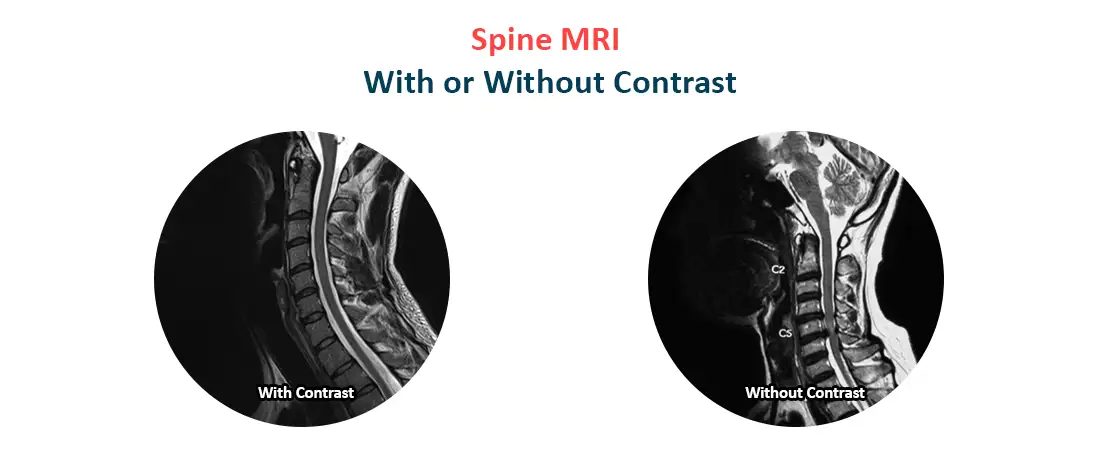
Magnetic resonance Imaging (MRI) has revolutionised medical diagnostics. One of the sparkling features of MRI is the examination of the entire spine known as “MRI Whole Spine”. The advanced diagnostic imaging...
A strong and healthy spine is the key to a well-functioning body. The spinal cord plays an important role in the Central Nervous System (CNS). As the spinal cord provides support to your body structure. God created a spine in such a way that protects the spinal cord, the column of nerves that connects your brain with the rest of the body. This whole system allows man to move freely and to bend with flexibility. Commonly, people overlook the importance of spine health until they experience certain back problems. And they don't know how MRI of spinal cord scans help.
Why MRI scans for Spinal Cord?
MRI whole spine evaluates the entire spinal column, including the cervical (neck), thoracic (mid back) and lumber (lower back).

Cervical spine MRI
Cervical Spine MRI Also known as C- Spine, it consists of seven cervical bones or vertebrae. Cervical MRI scan covers the neck region from the base of the skull to the beginning of the thoracic or mid back region. A cervical MRI also detects the structures like throat, thyroid gland, larynx, muscles of the neck, ligaments, tendon and soft tissues.
Thoracic Spine MRI
Thoracic segment of the spinal cord includes 12 vertebrae. It's a middle part of the back corresponding to the chest region, extending from the base of the neck to the lower back. Thoracic spine includes muscles, ligaments, tendons and intervertebral discs.
Lumbar Spine MRI
The lumbar spine is the lower portion of the back, it consists of 5 vertebrae. It connects the thorax to your pelvis and sacrum. It includes large muscles that help in movement of the lower back and carry heavy loads and lift.
MRI Detects the Variety of Spinal Problems

MRI is a best diagnostic technique that creates detailed pictures of the spine or detects the minor changes that happen with ageing.
These are some abnormalities which are examined by the Spine MRI:-
- Spinal fractures
- Spinal deformities- Spondylolisthesis or ankylosing spondylitis
- Bulging or herniated disc
- Degenerative disc disease
- Disc degeneration
- Disc height loss
- Vertebral malformation
- Muscle, tendon and ligament injury
- Spine infections
- Sclerosis
- Neuromuscular diseases
- Aneurysms and other blood vessels disorders
- Cysts
- Tumors in the spinal cord
- Injuries to nerves, muscles or ligaments of the spine
- Joint inflammation
- Abscess and other infections in the spinal cord
All You Should Know About Spine Damage
Any disruption of Spinal cord activity due to injury or disease can lead to serious conditions like loss of motor and sensory functions.
Cervical Spinal Cord Injury
Spinal cord injury in the cervical part is one of the most severe types of spinal cord injuries. It may result in loss of muscle strength in all four extremities.
An injury or problem in the cervical spine at C5-C6 may cause pain, weakness or paralysis on the arms or legs. In more severe cases there may be loss of bowel and bladder control or breathing problems in some cases.
Thoracic Spine Injury
Thoracic spinal cord injury causes inability to control bladder or bowel function. The vertebrae classified as thoracic are thought to have ribs. These are categorized as T1 through T12. Even though they are often fatal, thoracic spinal cord injuries are very serious. Injury to the thoracic spinal cord can occur on one or both sides of the body, and while there is a good long-term prognosis, prompt treatment is still essential.
Lumbar Spine Injury
Spinal cord injuries affecting the fifth lumbar vertebra (L-1 through L-5) typically cause some loss of function in the legs and hips, but not the upper body.
Spine MRI With or Without Contrast

Contrast agents aid in making certain tissues and structures more visible. Your doctors will determine whether to use contrast in a spine MRI based on the clinical question as well as any known or suspected medical conditions. MRI Spine with contrast might provide additional insights into your condition.
Conclusion
A healthy spine is integral to your overall health and well being. As you walk, bend, and lift, your spinal column—which extends from your neck to your tailbone—supports flexibility and mobility. An MRI of the spine can assist in identifying anomalies such as tumours, illness, disc herniation, muscle strains, and other soft tissue abnormalities.
MRI is the best test for detecting various conditions.If you are interested in spine screening don't wait, Book your whole spine screening today to take charge of your health and detect potential issues before you even develop symptoms.
Frequently Asked Questions Related Decoding Spinal Cord MRI
Why MRI is Best for Spine?
MRI images of the spine are comprehensive and clearer than images obtained from other diagnostic imaging methods. An MRI can reveal diseases, traumas, and abnormalities in the spine that other tests might miss. As far as imaging the spinal cord and nerves goes, magnetic resonance imaging (MRI) is the best option.
How Much Time Does a Full Spine MRI Take?
The spine MRI will take about thirty minutes to complete.
Does a Brain Appear on a Full Spine MRI?
Through an imaging test called magnetic resonance imaging of the spine and brain, your doctor can view detailed images of your spinal cord, brain, and spine. Inflammation, bleeding, nerve root compression, and other issues can be identified with its assistance. When investigating soft tissue or organs, MRI may be utilized in place of CT scans.
What is the Most Effective Lumbar Spine Treatment?
Physical Therapy: While exercise can help relieve lumbar spine pain, focused physical therapy is frequently preferable. You can make sure that the stretches and exercises you're doing are strengthening your spine and actively promoting spine healing by consulting with your physician or a certified physical therapist.
Are Injuries to the Spinal Cord Permanent?
Incomplete injuries to the spinal cord cannot be healed. The patient may experience significant healing, but they will have to live with a degree of sensory loss and movement impairment. Conversely, incomplete spinal cord injuries can be healed with the appropriate care and rest.
What is the Difference Between Back Injury and Spinal Cord Injury?
No, a back injury is not the same thing as spinal cord injury. Back injury affects the bones of the vertebral column but not the spinal cord.
Can MRI Show Nerve Damage of the Spine?
Indeed, an MRI scan is generally very sensitive to soft tissue structures such as bones and nerves. An MRI scan will undoubtedly reveal any abnormalities on the spinal cord and other veins surrounding the spine.










